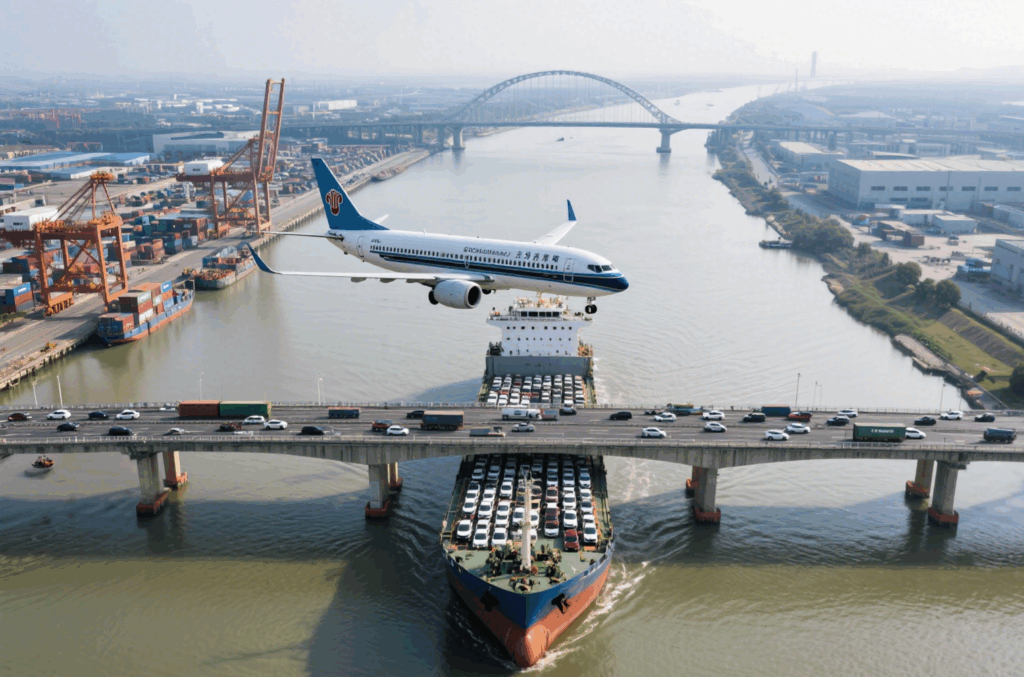Global trade between China and the United States has grown exponentially. For many importers, the shipping cost from China to USA per kg is a crucial factor in budgeting, especially when transporting electronics, textiles, machinery parts, and consumer goods. However, calculating per-kilogram rates is complex, as it depends on transport mode, cargo type, and customs requirements. Moreover, without proper planning, businesses risk paying unnecessary fees or experiencing shipping delays. This guide explains rates, methods, documents, and real-world strategies to manage costs effectively.
What Are the Main Shipping Methods from China to the USA?
Shippers generally choose between air freight, sea freight, express courier, and multimodal solutions. Each has unique costs and delivery times.
| Factor | Air Freight | Sea Freight (FCL/LCL) | Express Courier (DHL/FedEx/UPS) | Multimodal (Air + Truck) |
|---|---|---|---|---|
| Cost per kg/unit | $4–$8 per kg | $0.5–$1.5 per kg (in container) | $6–$12 per kg | $3–$6 per kg |
| Transit Time | 5–10 days | 25–40 days | 3–5 days | 12–18 days |
| Cargo Type | Mid/high-value, time-sensitive | Bulky, non-urgent, large volumes | Small parcels, urgent samples | Balanced loads |
| Environmental Impact | Higher footprint | Lowest per kg | Higher | Medium |
| Scalability | Limited by aircraft space | Scalable with containers | Restricted weight & size | Moderate flexibility |
Accordingly, importers often combine different methods depending on urgency and cost efficiency.
How Much Is the Shipping Cost from China to USA per kg?
The per-kilogram cost varies depending on the chosen shipping method.
| Method | Average Rate (USD) | Notes |
|---|---|---|
| Air Freight | $4–$8 per kg | Lower for bulk (100+ kg) |
| Express Courier | $6–$12 per kg | Best for <100 kg urgent goods |
| Sea Freight (FCL) | $0.5–$1.0 per kg | Calculated based on full container use |
| Sea Freight (LCL) | $1.0–$1.5 per kg | Includes consolidation fees |
| Multimodal Solutions | $3–$6 per kg | Useful for inland U.S. destinations |
For example, electronics weighing 300 kg shipped by air may cost around $1,500, while the same load in an FCL container could average under $500.

Which Routes Connect China and the USA?
Shipping routes depend on the port of origin in China and the final U.S. destination.
| POL (China) | POD (USA) | Transit Time (Sea) | Carriers/Services |
|---|---|---|---|
| Shanghai | Los Angeles | 15–20 days | COSCO, CMA, Evergreen |
| Shenzhen | New York | 30–35 days | OOCL, HMM, MSC |
| Ningbo | Houston | 28–32 days | ONE, Maersk, Hapag |
| Qingdao | Miami | 35–40 days | Yang Ming, ZIM |
On the other hand, air freight connects Shanghai, Beijing, and Shenzhen with major U.S. airports like LAX, JFK, ORD, and ATL within one week.
How Long Does It Take to Ship from China to the USA?
| Shipping Method | Estimated Transit Time |
|---|---|
| Air Freight | 5–10 days |
| Express Courier | 3–5 days |
| Sea Freight (FCL) | 25–35 days |
| Sea Freight (LCL) | 30–40 days (includes consolidation) |
| Multimodal (Air + Truck) | 12–18 days |
Although air freight is much faster, sea freight remains the preferred option for heavy or large shipments due to its low per-kilogram cost.

What Documents Are Needed for U.S. Imports?
To clear customs smoothly, importers must prepare these documents:
| Document | Purpose |
|---|---|
| Bill of Lading (B/L) / Airway Bill | Proof of shipment and ownership |
| Commercial Invoice | Declares product value |
| Packing List | Itemizes cargo contents |
| Certificate of Origin | Confirms manufacturing country |
| Importer Security Filing (ISF) | Mandatory for U.S. Customs (ocean freight) |
| Customs Bond | Guarantees duty/tax payment |
| Import License (if required) | Needed for restricted products |
Without a doubt, missing or incorrect paperwork may cause penalties and delays. Therefore, it is wise to rely on an experienced freight forwarder.
What Factors Affect Shipping Cost from China to USA per kg?
Several variables influence per-kilogram rates:
- Cargo Weight & Dimensions – Air carriers use chargeable weight (volume vs. actual).
- Shipping Method – Express courier vs. air vs. sea differ significantly.
- Distance & Routes – West Coast ports cost less than East Coast.
- Seasonality – Rates increase before holidays, Chinese New Year, and Black Friday.
- Fuel Prices – Bunker surcharges or jet fuel costs fluctuate.
- Customs & Duties – Tariffs vary by product category.
Moreover, logistics trends and carrier capacity agreements also impact long-term rates.
Pros and Cons of Different Shipping Methods
| Method | Pros | Cons |
|---|---|---|
| Air Freight | Fast, reliable, ideal for mid-high value | Expensive, limited space |
| Express Courier | Door-to-door, fastest, convenient | Highest cost per kg, strict limits |
| Sea Freight | Cheapest per kg, scalable, eco-friendly | Long transit, port delays possible |
| Multimodal | Balance between time and cost | More paperwork, complex coordination |
How to Reduce the Shipping Cost from China to USA per kg?
Importers can apply several strategies:
- Book early: advance rates are lower.
- Consolidate shipments: reduce per-unit costs.
- Select FOB terms: more control over carriers.
- Avoid peak seasons: ship before holiday demand surges.
- Optimize packaging: reduce dimensional weight in air freight.
- Choose West Coast ports: shorter transit lowers inland costs.
For example, consolidating textile shipments in Ningbo before sea export reduced per-unit costs by 12% for one U.S. retailer.
Real Case Studies
Case 1: Air Freight Electronics – Shenzhen → Los Angeles
- Cargo: 350 kg laptops
- Mode: Air Freight
- Cost: $1,600 (≈$4.57/kg)
- Transit: 7 days
- Result: Timely arrival for retail launch, cost higher but justified by urgency.
Case 2: Sea Freight Furniture – Ningbo → Houston
- Cargo: 1x40HQ (26 tons, furniture)
- Mode: FCL Sea Freight
- Cost: $5,200 (≈$0.20/kg)
- Transit: 30 days
- Result: Saved 70% per kg compared to air freight, aligned with seasonal sales schedule.
Conclusion
The shipping cost from China to USA per kg depends on method, cargo type, and market conditions. Importers who book early, consolidate shipments, and choose efficient routes can save significantly. To summarize, sea freight provides the lowest cost per kg for bulk goods, while air and courier services deliver speed at higher rates. Ultimately, businesses that understand per-kilogram pricing can balance cost and delivery times, ensuring efficient and profitable supply chains between China and the USA.
Request a Quote
Need a tailored solution for your shipping from China?
Let TJ China Freight Forwarder assist you with reliable, cost-effective service.
FAQs
Q1.What is the cheapest way to ship from China to the USA per kg?
The cheapest method is sea freight using FCL (Full Container Load). For shipments above 500 kg, this option reduces the shipping cost from China to USA per kg to as low as $0.20–$0.50. Although it requires longer transit, typically 25–35 days, the savings per kilogram are substantial. Importers dealing with heavy cargo such as machinery, furniture, or bulk textiles often rely on FCL shipping. Additionally, consolidating orders before departure ensures lower rates compared to smaller LCL shipments.
Q2.Can small shipments be shipped cost-effectively per kg?
Yes. Importers sending under 100 kg can use express courier shipping from China with providers like DHL, FedEx, or UPS. This service costs about $6–$12 per kg and arrives within 3–5 days. For loads between 100–300 kg, air freight from China to USA cost per kg averages $4–$8. Although these rates are higher than sea freight, they are practical for urgent samples, electronics, or apparel. Consolidating several small packages into one shipment further reduces handling fees and improves cost efficiency.
Q3.How does dimensional weight affect air freight cost?
Airlines calculate charges based on the greater of actual or volumetric weight. For instance, bulky but lightweight goods such as pillows may be billed using volumetric formulas. As a result, the air freight shipping cost from China to USA per kg can rise unexpectedly. To manage expenses, importers should optimize packaging and reduce wasted space. Additionally, freight forwarders can recommend suitable airlines and routes to lower costs. Careful packaging design ensures the charged weight aligns closely with actual cargo, helping businesses save money per kilogram.
Q4.Which U.S. ports are best for sea freight imports from China?
For bulk cargo, sea freight FCL rates from China to USA are cheapest when routed to West Coast ports such as Los Angeles and Long Beach. Transit time averages 15–20 days, and per-kilogram rates can be as low as $0.25. On the other hand, importers closer to the East Coast often use New York or Savannah despite longer transit times of 30–35 days. Choosing the right port balances delivery speed, inland trucking distance, and total cost per kilogram. Forwarders can also optimize routes to inland markets.
Q5.Do customs duties affect per kg shipping cost?
Yes. U.S. Customs duties significantly influence the landed cost per kilogram for imports from China. Charges are based on HS codes, declared value, and product type. For example, electronics may face higher tariffs than apparel or household goods. In addition, importers must pay customs bond fees and possible anti-dumping duties. Including these costs in per-kilogram calculations ensures accurate budgeting. Many importers work with licensed brokers who manage duty payments and provide advanced duty estimates. This minimizes delays and prevents unexpected expenses during customs clearance.

